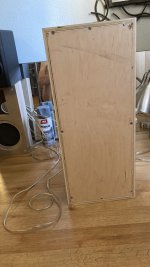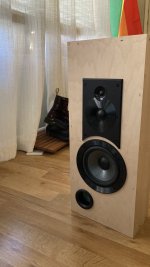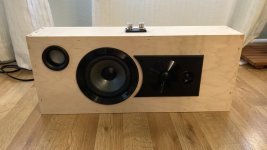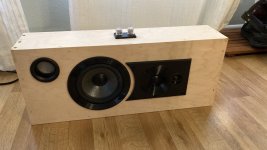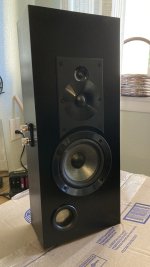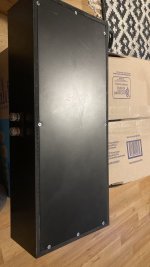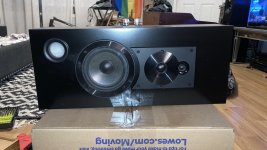Yeah I should have thought of the fish. I’m going to paint it so I’m not so worried of the speaker itself. I’ll ask my SO what she thinks of the fish issue. I’m not sure where else I can mount it besides in front on a stand or above the TV which would put it at 6’ about the floor. I’d like to try and get less bass since the original speaker already has a little bit too much so maybe going with sealing it wouldn’t be a bad idea.
Hmmm.... the TV is also above the fish tank.
Likely not as bad as putting it in front of a fireplace above the 40th latitude.... but... humidity? salts?
You can always put the port in the side and with the smaller box the tuning would be higher.
As you have the original internal volume and port it's easy to model the smaller volume in WinISD to determine a longer port even without having the driver parameters.
As you have the original internal volume and port it's easy to model the smaller volume in WinISD to determine a longer port even without having the driver parameters.
humidity? salts?
Perhaps it's a freshwater fish tank - no heater - minimal humidity - no salts.
The fish will die soon, if heavy bass is played.
Unless they are a hardy breed.
You can place the speakers near or under the place where you normally sit, easier on you and the fish.
And you will good bass, put the woofer under the seat.
Unless they are a hardy breed.
You can place the speakers near or under the place where you normally sit, easier on you and the fish.
And you will good bass, put the woofer under the seat.
From a HT design POV this is normally one's best choice for any non perforated screen app since in a cinema the HF is at 2/3 screen height where the bulk of the dialog emanates, so we're typically use to it being at least at seated head height and historically higher, so above the screen angled down and toe'd in as required solves location and polar, floor/ceiling 'bounce' response issues, reducing/negating side wall, etc., treatment till behind the listening area (LP), which should be diffuse in nature and fore/aft polar offsets are well within a typical HT receiver's time delay correction.or above the TV
Alright, I apologize for not communicating well in my first post. I had finished the build and it seems very near to original. I think it sounds a bit better. Maybe because it’s more stiff than the 1/2” mdf plus I added a bit of stuffing. I also reduced the internal volume to about 400 in^3. The new dimensions are 20.5” x 8.5” x 4.5” with 3/4” maple plywood (the good domestic plywood from Columbia).
I need to paint and fill it, but it’s basically ready to use. The back can be removed for easier access and it has a foam seal plus threaded inserts so that it doesn’t just strip the screw holes. I’m going to keep the plastic end caps of the port and maybe try to find a good length, but it doesn’t sound like it really needs the adjustment. I messed up on squaring the joints on the angled parts when gluing it so the back needed some adjustment to fit, but it worked out fine. Thank you all for the suggestions and politeness. A lot of places aren’t very receptive to these kind of small budget Frankenstein builds. I might even rebuild it at some point and use more for the advice given. I would also make it easier to build and keep square.
I need to paint and fill it, but it’s basically ready to use. The back can be removed for easier access and it has a foam seal plus threaded inserts so that it doesn’t just strip the screw holes. I’m going to keep the plastic end caps of the port and maybe try to find a good length, but it doesn’t sound like it really needs the adjustment. I messed up on squaring the joints on the angled parts when gluing it so the back needed some adjustment to fit, but it worked out fine. Thank you all for the suggestions and politeness. A lot of places aren’t very receptive to these kind of small budget Frankenstein builds. I might even rebuild it at some point and use more for the advice given. I would also make it easier to build and keep square.
Attachments
I can’t even slide the table the 40 gallon tank is on. That sucker ain’t moving.Maybe move the fish tank
Galu has it right. There’s no way the fish won’t notice that they’ve been evicted for a center channel.
Do you mean like a trim all around the front corners? That would be a good, plus I can just add it on to the box I have.you could add bacl the removed internal volume to the sides of your new creation since you did not like the depth of the cabinet. The wider cabinet will help to launch lower frequencies more effectively than the original narrow cabinet. You might even add a large front edge 1/4 round which will help to smooth your horizontal dispersion as well.
Yeah I guess that would be a better position either way. The fish won’t like it about their tank and neither would I.From a HT design POV this is normally one's best choice for any non perforated screen app since in a cinema the HF is at 2/3 screen height where the bulk of the dialog emanates, so we're typically use to it being at least at seated head height and historically higher, so above the screen angled down and toe'd in as required solves location and polar, floor/ceiling 'bounce' response issues, reducing/negating side wall, etc., treatment till behind the listening area (LP), which should be diffuse in nature and fore/aft polar offsets are well within a typical HT receiver's time delay correction.
On its side, but it can be mounted upright if it’s above the TVGroundunit, are you laying the speaker over on its side or upright?
It’s a freshwater, but the humidity plus any splash would definitely adversely affect the finish. It would also, as many have pointed out, be a bad idea given that there would be a lot of interference with the water and lives of the fish.Hmmm.... the TV is also above the fish tank.
Likely not as bad as putting it in front of a fireplace above the 40th latitude.... but... humidity? salts?
I’ll need to do a bit of research on thatWhat would you do if you had thiele/small parameters?
actually looks like more airspace than factory.
should be ok
box looks well stuffed for good mids.
seems likely the port is too short.
for the box size
So it is high tuned.
you could plug the port
or just add length to turn lower.
reverse engineer factory box volume
and port length to find tune frequency.
then add length to your port
to get same frequency with the larger box you
made.
seems like a decent mid and tweeter
so very nice for clear voices and speech
should be ok
box looks well stuffed for good mids.
seems likely the port is too short.
for the box size
So it is high tuned.
you could plug the port
or just add length to turn lower.
reverse engineer factory box volume
and port length to find tune frequency.
then add length to your port
to get same frequency with the larger box you
made.
seems like a decent mid and tweeter
so very nice for clear voices and speech
The decrease in internal volume may not be too significant, representing as it does a reduction of around 10%.
To recap so others don't have to search the thread:
Original Sony bookshelf speaker enclosure: 448 cu in
Final centre speaker enclosure: 400 cu in
To recap so others don't have to search the thread:
Original Sony bookshelf speaker enclosure: 448 cu in
Final centre speaker enclosure: 400 cu in
tl;dr: speaker is done, deciding horizontal or vertical mounting, the long and arduous journey of painting something black, then applying polyurethane clear coat. Pictures.
Thank you for summing that up! I do have a little update on the speaker. I finished the build and now am deciding how to mount it. It’s going to be above the TV, but I’m still trying to decide whether I’ll stick with horizontal mounting or vertical. I’ll need to reread previous comments to see if someone had answered that.
In regards to the finishing, it took me a bit longer than it should have since I used a flat black, I was spraying outside (using a box to cover during drying), and some mistakes in the wet sanding process. Any sort of rub on the paint would make it glossy so after repainting (this coming out even smoother) I asked the finisher at work what would be a good clear coat for a flat black paint. He said that I should try polyurethane or water based clear coat since the regular clear coat we have is glossy. I was only able to find a satin polyurethane so it’s a little more shiny than flat, but it still looks great. Easy to spray on with good wet sanding prepping. It definitely has a self leveling property that really helped when I tried to get a stray hair out in the middle of spraying!
I hope it still has the same decent sound up high as it did during testing. Attached are a few pictures of it. Take note of the input position. Originally I was set on having it against a wall near flat, horizontally mounted. At some point I might add a secondary input on the rear or short side.
Thank you for summing that up! I do have a little update on the speaker. I finished the build and now am deciding how to mount it. It’s going to be above the TV, but I’m still trying to decide whether I’ll stick with horizontal mounting or vertical. I’ll need to reread previous comments to see if someone had answered that.
In regards to the finishing, it took me a bit longer than it should have since I used a flat black, I was spraying outside (using a box to cover during drying), and some mistakes in the wet sanding process. Any sort of rub on the paint would make it glossy so after repainting (this coming out even smoother) I asked the finisher at work what would be a good clear coat for a flat black paint. He said that I should try polyurethane or water based clear coat since the regular clear coat we have is glossy. I was only able to find a satin polyurethane so it’s a little more shiny than flat, but it still looks great. Easy to spray on with good wet sanding prepping. It definitely has a self leveling property that really helped when I tried to get a stray hair out in the middle of spraying!
I hope it still has the same decent sound up high as it did during testing. Attached are a few pictures of it. Take note of the input position. Originally I was set on having it against a wall near flat, horizontally mounted. At some point I might add a secondary input on the rear or short side.
Attachments
Yes, the finish looks great!
A nice example of repurposing.
I guess you will have to experiment with horizontal or vertical mounting - no one has so far stated a preference.
A nice example of repurposing.
I guess you will have to experiment with horizontal or vertical mounting - no one has so far stated a preference.
I've had suprisingly good results from black rattle can followed by black boot polish. On my next build I think I'll try polyurethane clear coat though.
Thx Galu, yea I will need to experiment. I may also need to play with the port length as someone else said.
Cracked Case, I’ve never heard of using black boot polish. That’s a great idea.
Cracked Case, I’ve never heard of using black boot polish. That’s a great idea.
I may also need to play with the port length as someone else said.
You said earlier that you have simply kept the flared plastic end cap of the port and have not included the port tube itself.
The problem with introducing a port tube in your narrow enclosure is that there should be at least a couple of inches of clearance between the rear of the tube and the inside rear wall of the enclosure in order to allow the plug of air in the port tube to oscillate freely.
Looking at the amount of stuffing you have used, any interaction between the woofer and the plug of air in the port has probably been suppressed, making the enclosure behave more like sealed or aperiodic (resistive vent) one.
I would be tempted to leave well enough alone, especially since you say the enclosure sounds better than the original.
- Home
- Loudspeakers
- Multi-Way
- I cut my speaker in half & I need help restoring the sound
